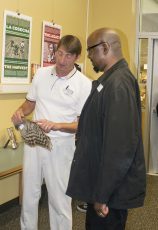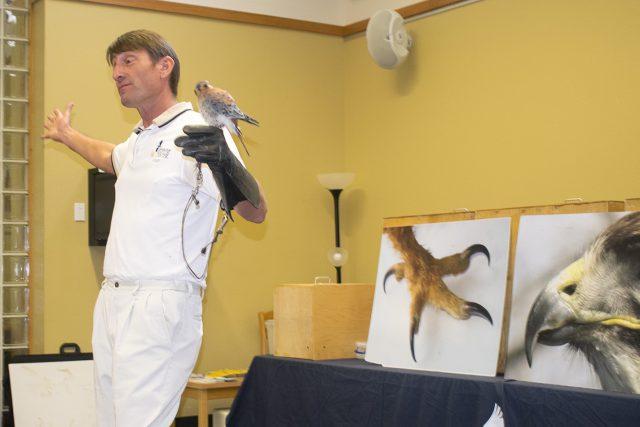By Lana Shuck/reporter

Native raptors are important to the environment because they eat pests and can alert us to common dangers, a speaker told a SE Campus audience Sept. 5.
Erich Neupert, executive director of the Blackland Prairie Raptor Center in Allen, introduced formerly injured raptors now living at the 66-acre facility that has treated 600 raptors so far this year, including bald eagles.
“Do I need to take a wild animal home? No, especially birds,” Neupert said. “Because what happens with these guys is then they open their eyes and you’re the one feeding them. They see you, and they associate with you, and can you teach them to hunt? Can you teach them to be a falcon?”
He introduced Orville, an American kestrel, who can never be released into the wild. All raptors except vultures eat live prey, but Orville is dependent on humans for his food.
Neupert said all U.S. birds are protected by the Migratory Birds Treaty Act except for starlings, sparrows and pigeons, so anyone shooting, poisoning or purposefully harming these birds can be fined or put in jail.
Neupert listed unique traits of four more Texas raptors as he introduced them. Sweet Pea, an injured eastern screech owl, flies silently. She can turn her head 270 degrees, and her favorite meal is cockroaches. Beaker, a barred owl, lost a wing tip but has asymmetrical ears so he can hear a heartbeat 20 feet away. A red-shouldered hawk with one blind eye from falling early from his nest and a red-tailed hawk with two broken wings cannot survive in the wild again, but both hawks have scales on their feet, like armor, so they can pick up dangerous prey like rattlesnakes.
What should someone do if they find an injured bird or raptor?
“The best thing to do is call us at BPRC or Rogers Wildlife Rehabilitation Center, and if it is small you could probably put it in a box but don’t feed it,” Neupert said. “Good Samaritans can keep a bird for 72 hours legally.”
Neupert also pointed out one bird that makes even a cheetah look slow.
“A peregrine falcon is the fastest animal in the world at about two pounds, and when diving they’ve been reported doing 200 to 230 miles per hour,” Neupert said.
SE student Erick Martinez said he learned a lot but liked one fact, in particular.
“I learned the fastest animal is a bird,” Martinez said.
The presentation was one of the SE library’s series Native Voices: Native Peoples’ Concepts of Health and Illness.




































